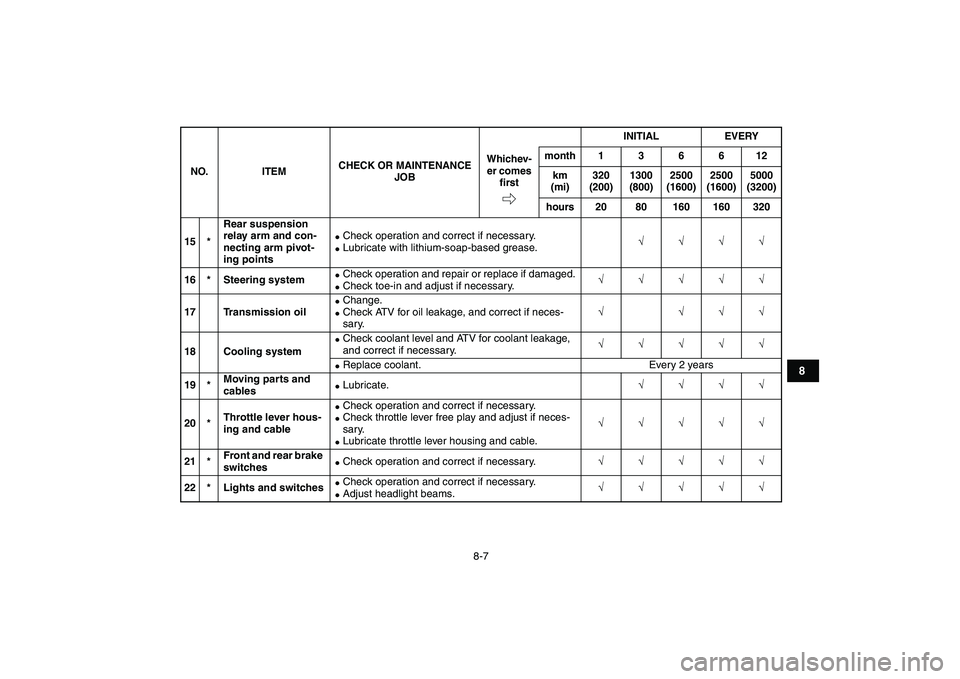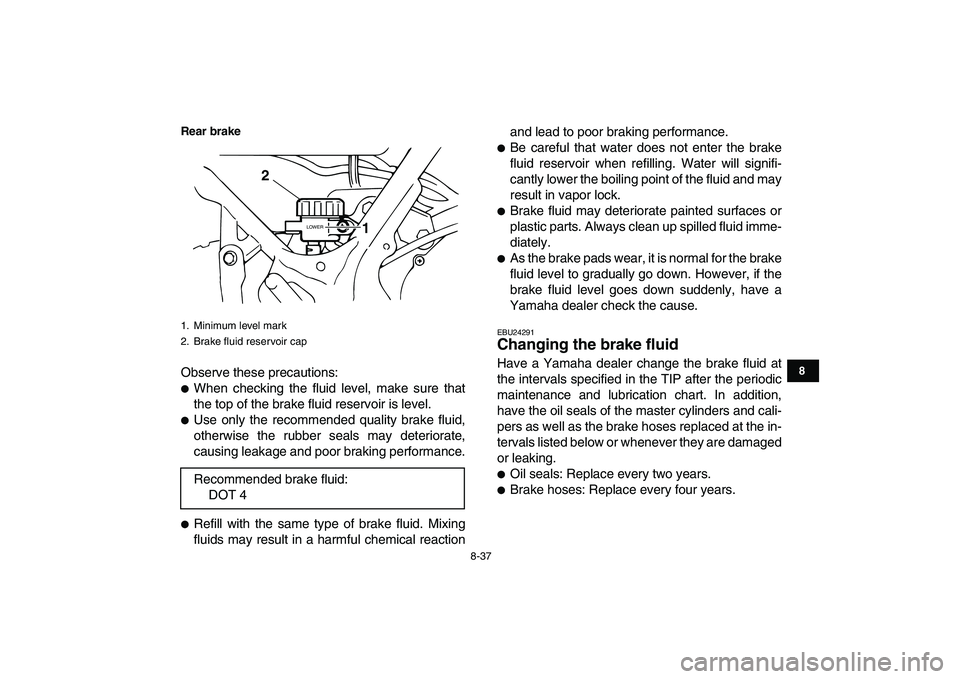Page 85 of 148

8-7
1
2
3
4
5
6
78
9
10
11
15 *Rear suspension
relay arm and con-
necting arm pivot-
ing points
�
Check operation and correct if necessary.
�
Lubricate with lithium-soap-based grease.
√√√√
16 * Steering system
�
Check operation and repair or replace if damaged.
�
Check toe-in and adjust if necessary.
√√√√√
17 Transmission oil
�
Change.
�
Check ATV for oil leakage, and correct if neces-
sary.
√ √√√
18 Cooling system
�
Check coolant level and ATV for coolant leakage,
and correct if necessary.
√√√√√
�
Replace coolant. Every 2 years
19 *Moving parts and
cables
�
Lubricate.
√√√√
20 *Throttle lever hous-
ing and cable
�
Check operation and correct if necessary.
�
Check throttle lever free play and adjust if neces-
sary.
�
Lubricate throttle lever housing and cable.
√√√√√
21 *Front and rear brake
switches
�
Check operation and correct if necessary.
√√√√√
22 * Lights and switches
�
Check operation and correct if necessary.
�
Adjust headlight beams.
√√√√√
NO. ITEMCHECK OR MAINTENANCE
JOBINITIAL EVERY
Whichev-
er comes
firstmonth136612
km
(mi)320
(200)1300
(800)2500
(1600)2500
(1600)5000
(3200)
hours 20 80 160 160 320
Page 89 of 148
8-11
1
2
3
4
5
6
78
9
10
11
fore each ride. In addition, the transmission oil
must be changed at the intervals specified in the
periodic maintenance and lubrication chart.
To check the transmission oil level
1. Place the ATV on a level surface.
2. Start the engine, warm it up for several min-
utes, and then turn it off.
3. Wait a few minutes until the oil settles, remove
the transmission oil filler cap, wipe the dipstick
off with a clean rag, insert it back into the oil
filler hole (without screwing it in), and then re-
move it again to check the oil level.TIP
The transmission oil should be between the tip of
the dipstick and the maximum level mark.
4. If the oil is at or below the tip of the dipstick,
add sufficient oil of the recommended type to
raise it to the correct level.
5. Insert the dipstick into the oil filler hole, and
then tighten the oil filler cap.
1. Dipstick
2. Maximum level mark
3. Tip of the dipstick
4. Transmission oil filler cap
12
34
Page 90 of 148

8-12
1
2
3
4
5
6
78
9
10
11
To change the transmission oil
1. Place the ATV on a level surface.
2. Start the engine, warm it up for several min-
utes, and then turn it off.
3. Place an oil pan under the transmission case
to collect the used oil.
4. Remove the oil filler cap, the transmission oil
drain bolt and its gasket to drain the oil from
the transmission case.
5. Install the transmission oil drain bolt and its
new gasket, and then tighten the bolt to the
specified torque.6. Refill with the specified amount of the recom-
mended transmission oil, and then install and
tighten the oil filler cap.TIP
Be sure to wipe off spilled oil on any parts after the
engine and exhaust system have cooled down.NOTICE
ECB00430
�
In order to prevent clutch slippage (since the
transmission oil also lubricates the clutch),
do not mix any chemical additives. Do not
use oils with a diesel specification of “CD” or
oils of a higher quality than specified. In ad-
dition, do not use oils labeled “ENERGY
CONSERVING II” or higher.
�
Make sure that no foreign material enters the
1. Transmission oil drain bolt
2. Gasket
1
12
Tightening torque:
Transmission oil drain bolt:
20 Nm (2.0 m·kgf, 14 ft·lbf)
Recommended transmission oil:
See page 10-1.
Oil quantity:
1.5 L (1.59 US qt, 1.32 Imp.qt)
Page 91 of 148
8-13
1
2
3
4
5
6
78
9
10
11
crankcase.
7. Start the engine, and then let it idle for several
minutes while checking it for oil leakage. If oil
is leaking, immediately turn the engine off and
check for the cause.
8. Turn the engine off, and then check the oil lev-
el and correct it if necessary.
EBU23470
Coolant
The coolant level should be checked before each
ride. In addition, the coolant must be changed at
the intervals specified in the periodic maintenance
and lubrication chart.
EBU23502
To check the coolant level
1. Place the ATV on a level surface.
TIP
The coolant level must be checked on a cold en-
gine since the level varies with engine tempera-
ture.
2. Check the coolant level in the coolant reser-
voir.
TIP
The coolant should be between the minimum and
maximum level marks.
3. If the coolant is at or below the minimum level
mark, remove the seat. (See page 4-11.)
4. Open the coolant reservoir cover.
1. Maximum level mark
2. Minimum level mark
1
2
Page 115 of 148

8-37
1
2
3
4
5
6
78
9
10
11
Rear brake
Observe these precautions:
�
When checking the fluid level, make sure that
the top of the brake fluid reservoir is level.
�
Use only the recommended quality brake fluid,
otherwise the rubber seals may deteriorate,
causing leakage and poor braking performance.
�
Refill with the same type of brake fluid. Mixing
fluids may result in a harmful chemical reactionand lead to poor braking performance.
�
Be careful that water does not enter the brake
fluid reservoir when refilling. Water will signifi-
cantly lower the boiling point of the fluid and may
result in vapor lock.
�
Brake fluid may deteriorate painted surfaces or
plastic parts. Always clean up spilled fluid imme-
diately.
�
As the brake pads wear, it is normal for the brake
fluid level to gradually go down. However, if the
brake fluid level goes down suddenly, have a
Yamaha dealer check the cause.
EBU24291
Changing the brake fluid
Have a Yamaha dealer change the brake fluid at
the intervals specified in the TIP after the periodic
maintenance and lubrication chart. In addition,
have the oil seals of the master cylinders and cali-
pers as well as the brake hoses replaced at the in-
tervals listed below or whenever they are damaged
or leaking.
�
Oil seals: Replace every two years.
�
Brake hoses: Replace every four years.
1. Minimum level mark
2. Brake fluid reservoir cap
Recommended brake fluid:
DOT 4
LOWER
1 2